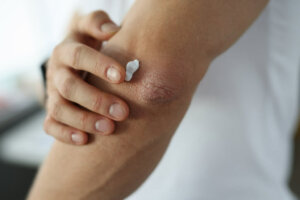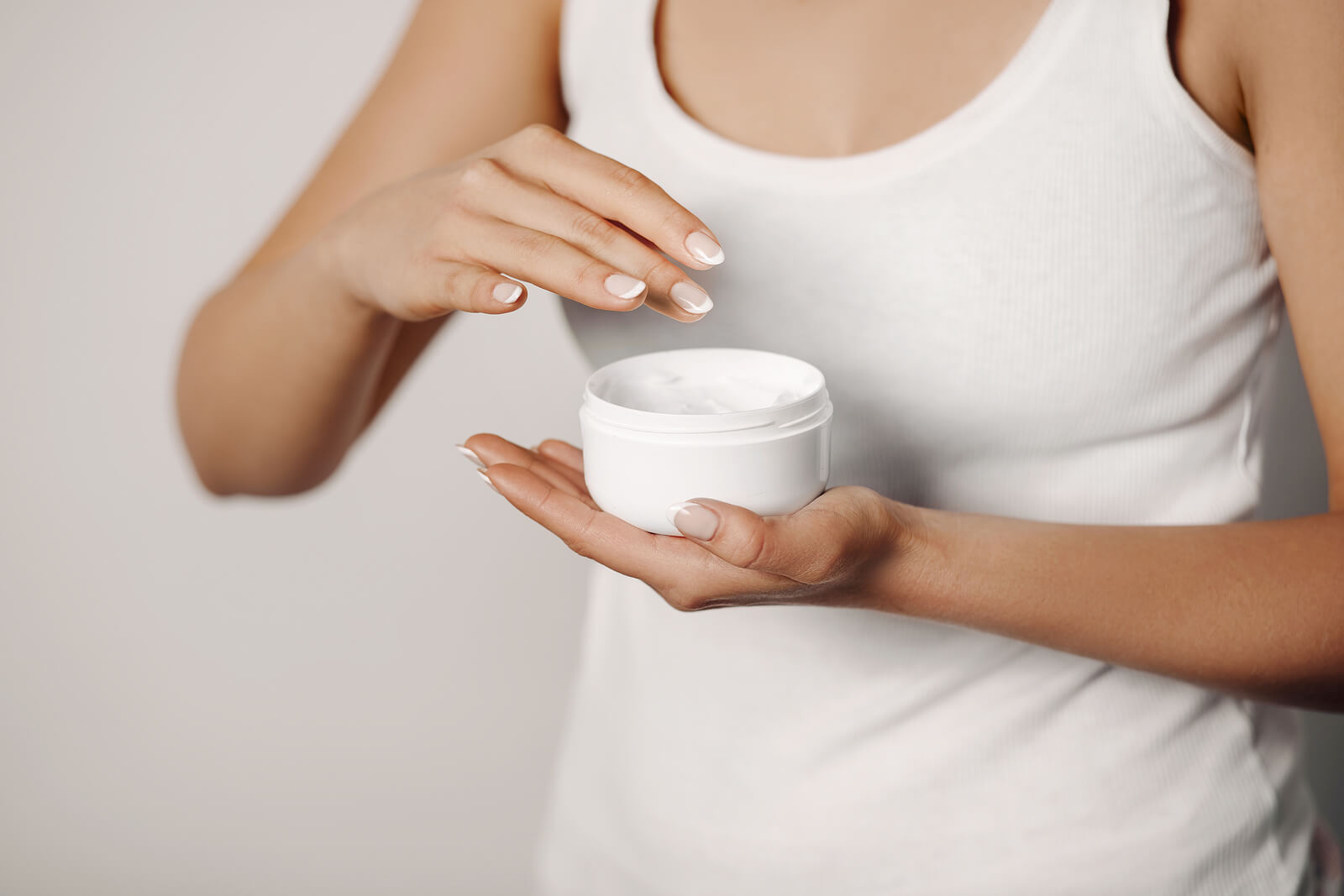Treatment of Contact Dermatitis

Sometimes, we may put on a bracelet or change our perfume, deodorant or lotion, and notice that our skin becomes red, sensitive, itchy, dry, and with other discomforts. Treatment of contact dermatitis is something you’ll have to resort to.
The treatment of contact dermatitis aims to alleviate the discomfort to prevent it from worsening and prolonging over time. In milder cases, it may consist of some basic self-care and measures, while in others it may require the use of one or more types of medications. Let’s see more about it below.
Over the counter drugs
In mild cases, some over-the-counter medications can be used to relieve contact dermatitis. The pharmacist can offer guidance on what may be the most appropriate options.
- Hydrocortisone creams to relieve itching, irritation, and inflammation.
- Calamine lotions without steroids / oral antihistamines to relieve itching and rash.
Prescriptions

As the scientific literature shows, when contact dermatitis doesn’t improve with self-care or over-the-counter medications, the dermatologist may consider prescribing one of the following medications:
- Topical corticosteroids (or steroid creams): hydrocortisone, triamcinolone, and clobetasol.
- Oral corticosteroid: prednisone.
- Oral antibiotics (only in case of infection).
- Topical immunomodulators to treat inflammation in severe cases. It’s also used in cases of atopic dermatitis.
Phototherapy
When the above treatment options for contact dermatitis don’t work, phototherapy is used, which is one of the specialized procedures that has been shown to be helpful in cases of dermatitis. This can only be applied by the dermatologist.
Home remedies and lifestyle
Fortunately, in many cases, it’s enough to apply some self-care and home remedies to alleviate the discomfort caused by contact dermatitis. Among the most prominent we find the following.
In mild cases, self-care and home remedies should be maintained for at least 3 weeks (which is usually the average duration of dermatitis) so that the affected area can heal.
Identify and avoid the offending substance
While it’s true that in some cases it’s easy to identify the substance that caused contact dermatitis, in others it can be challenging. However, the important thing is to try to do so in order to avoid further contact and to inform the doctor in more detail about the reaction.
Sometimes, when changing your deodorant, lipstick, perfume or cream and noticing that the areas where the product was applied are sensitive, it isn’t difficult to suspect contact dermatitis.
- Minimizing exposure in the workplace using protective equipment (gloves and mask) is very useful.
- If it isn’t possible to dispense with the use of the garment that caused the reaction (such as a piece of costume jewelry or a piece of clothing), it’s advisable to place a barrier between it and the skin. For example, the jewelry piece can be coated with clear nail polish to prevent it from touching the skin directly.
Apply cold compresses
A cold compress can be of great help in relieving inflammation and other acute complaints. While this isn’t a definitive solution, it is a good way to get temporary relief. Now, to take advantage of it, it’s advisable to wrap it in gauze or a fine cloth, to avoid further mistreating the skin.
Warm baths or oatmeal baths
Washes (or baths, depending on the number of affected areas) are also good ways to get relief when contact dermatitis has occurred. It’s important that the water is neither too hot nor too cold, as this can exacerbate the discomfort. Ideally, the water should be warm.
- One ingredient that can soothe discomfort is colloidal oatmeal, which has anti-inflammatory and pain-relieving properties according to various studies.
- Another useful ingredient that also contributes to relief in cases of contact or atopic dermatitis is sodium bicarbonate.
- Any of these ingredients should be used sparingly and preferably individually, not in combination.
- Additionally, you need to avoid bubble baths, soaps and hygiene products that have fragrances.
Hydrate often

One of the consequences of contact dermatitis is dry skin. Therefore, it is necessary to regularly apply a product that hydrates it without fragrances. For added safety, a hypoallergenic cream or lotion can be chosen.
- The product should be applied several times a day (even before going to sleep) in order to rehydrate, soothe the area and heal the skin.
Cover the affected area
In order for the skin to heal properly, you need to avoid constant scratching and handling. In this regard, it may be helpful to keep it covered with a piece of clothing or gauze.
When to go to the doctor?
If you suspect that you suffer from contact dermatitis and self-care and home remedies aren’t contributing to the relief after applying them for 2-3 weeks, it’s best to consult with your pharmacist or dermatologist.
On the other hand, if you have blisters, fever and other symptoms, don’t hesitate to contact your doctor to receive the most appropriate treatment.
Sometimes, we may put on a bracelet or change our perfume, deodorant or lotion, and notice that our skin becomes red, sensitive, itchy, dry, and with other discomforts. Treatment of contact dermatitis is something you’ll have to resort to.
The treatment of contact dermatitis aims to alleviate the discomfort to prevent it from worsening and prolonging over time. In milder cases, it may consist of some basic self-care and measures, while in others it may require the use of one or more types of medications. Let’s see more about it below.
Over the counter drugs
In mild cases, some over-the-counter medications can be used to relieve contact dermatitis. The pharmacist can offer guidance on what may be the most appropriate options.
- Hydrocortisone creams to relieve itching, irritation, and inflammation.
- Calamine lotions without steroids / oral antihistamines to relieve itching and rash.
Prescriptions

As the scientific literature shows, when contact dermatitis doesn’t improve with self-care or over-the-counter medications, the dermatologist may consider prescribing one of the following medications:
- Topical corticosteroids (or steroid creams): hydrocortisone, triamcinolone, and clobetasol.
- Oral corticosteroid: prednisone.
- Oral antibiotics (only in case of infection).
- Topical immunomodulators to treat inflammation in severe cases. It’s also used in cases of atopic dermatitis.
Phototherapy
When the above treatment options for contact dermatitis don’t work, phototherapy is used, which is one of the specialized procedures that has been shown to be helpful in cases of dermatitis. This can only be applied by the dermatologist.
Home remedies and lifestyle
Fortunately, in many cases, it’s enough to apply some self-care and home remedies to alleviate the discomfort caused by contact dermatitis. Among the most prominent we find the following.
In mild cases, self-care and home remedies should be maintained for at least 3 weeks (which is usually the average duration of dermatitis) so that the affected area can heal.
Identify and avoid the offending substance
While it’s true that in some cases it’s easy to identify the substance that caused contact dermatitis, in others it can be challenging. However, the important thing is to try to do so in order to avoid further contact and to inform the doctor in more detail about the reaction.
Sometimes, when changing your deodorant, lipstick, perfume or cream and noticing that the areas where the product was applied are sensitive, it isn’t difficult to suspect contact dermatitis.
- Minimizing exposure in the workplace using protective equipment (gloves and mask) is very useful.
- If it isn’t possible to dispense with the use of the garment that caused the reaction (such as a piece of costume jewelry or a piece of clothing), it’s advisable to place a barrier between it and the skin. For example, the jewelry piece can be coated with clear nail polish to prevent it from touching the skin directly.
Apply cold compresses
A cold compress can be of great help in relieving inflammation and other acute complaints. While this isn’t a definitive solution, it is a good way to get temporary relief. Now, to take advantage of it, it’s advisable to wrap it in gauze or a fine cloth, to avoid further mistreating the skin.
Warm baths or oatmeal baths
Washes (or baths, depending on the number of affected areas) are also good ways to get relief when contact dermatitis has occurred. It’s important that the water is neither too hot nor too cold, as this can exacerbate the discomfort. Ideally, the water should be warm.
- One ingredient that can soothe discomfort is colloidal oatmeal, which has anti-inflammatory and pain-relieving properties according to various studies.
- Another useful ingredient that also contributes to relief in cases of contact or atopic dermatitis is sodium bicarbonate.
- Any of these ingredients should be used sparingly and preferably individually, not in combination.
- Additionally, you need to avoid bubble baths, soaps and hygiene products that have fragrances.
Hydrate often

One of the consequences of contact dermatitis is dry skin. Therefore, it is necessary to regularly apply a product that hydrates it without fragrances. For added safety, a hypoallergenic cream or lotion can be chosen.
- The product should be applied several times a day (even before going to sleep) in order to rehydrate, soothe the area and heal the skin.
Cover the affected area
In order for the skin to heal properly, you need to avoid constant scratching and handling. In this regard, it may be helpful to keep it covered with a piece of clothing or gauze.
When to go to the doctor?
If you suspect that you suffer from contact dermatitis and self-care and home remedies aren’t contributing to the relief after applying them for 2-3 weeks, it’s best to consult with your pharmacist or dermatologist.
On the other hand, if you have blisters, fever and other symptoms, don’t hesitate to contact your doctor to receive the most appropriate treatment.
- Dermatitis de contacto | Contact Dermatitis [Internet]. American Academy of Allergy, Asthma & Immunology. [cited 2021 Jul 6]. Available from: https://www.aaaai.org/Tools-for-the-Public/Biblioteca-de-condiciones/Biblioteca-de-alergia/Dermatitis-de-contacto-Informacion-generalGonzalez ME.
- Dermatitis de contacto – Trastornos dermatológicos [Internet]. Manual MSD versión para profesionales. 2019 [cited 2021 Jul 6]. Available from: https://www.msdmanuals.com/es/professional/trastornos-dermatológicos/dermatitis/dermatitis-de-contacto
- Méndez-Cabeza Velazquez J, Alache Zúñiga H. Manejo de la dermatitis en atención primaria. MEDIFAM [Internet]. 2003 Feb [cited 2021 Jul 6];13(2):75–84. Available from: https://scielo.isciii.es/pdf/medif/v13n2/colabora2.pdf
- Litchman G, Nair PA, Atwater AR, et al. Contact Dermatitis. [Updated 2021 Feb 7]. In: StatPearls [Internet]. Treasure Island (FL): StatPearls Publishing; 2021 Jan-. Available from: https://www.ncbi.nlm.nih.gov/books/NBK459230/
- Pérez-Ferriols A, Aranegui B, Pujol-Montcusí JA, Martín-Gorgojo A, Campos-Domínguez M, Feltes RA, et al. Modalidades de fototerapia para el tratamiento de la dermatitis atópica: revisión sistemática de la literatura. Actas Dermosifiliogr [Internet]. 2015 Jun 1 [cited 2021 Jul 6];106(5):387–401. Available from: http://www.actasdermo.org/es-modalidades-fototerapia-el-tratamiento-dermatitis-articulo-S0001731015000496
- Puig Sanz L. Dermatitis de contacto. Alergia e irritación . Farm Prof [Internet]. 2002 Sep [cited 2021 Jul 6];16(8):88–97. Available from: https://www.elsevier.es/es-revista-farmacia-profesional-3-articulo-dermatitis-contacto-alergia-e-irritacion-13036533
Este texto se ofrece únicamente con propósitos informativos y no reemplaza la consulta con un profesional. Ante dudas, consulta a tu especialista.







